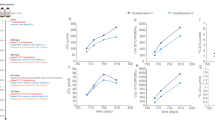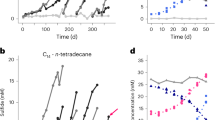Abstract
Methanogenic degradation of crude oil hydrocarbons is an important process in subsurface petroleum reservoirs and anoxic environments contaminated with petroleum. There are several possible routes whereby hydrocarbons may be converted to methane: (i) complete oxidation of alkanes to H2 and CO2, linked to methanogenesis from CO2 reduction; (ii) oxidation of alkanes to acetate and H2, linked to acetoclastic methanogenesis and CO2 reduction; (iii) oxidation of alkanes to acetate and H2, linked to syntrophic acetate oxidation and methanogenesis from CO2 reduction; (iv) oxidation of alkanes to acetate alone, linked to acetoclastic methanogenesis and (v) oxidation of alkanes to acetate alone, linked to syntrophic acetate oxidation and methanogenesis from CO2 reduction. We have developed the concept of a ‘window of opportunity’ to evaluate the range of conditions under which each route is thermodynamically feasible. On this basis the largest window of opportunity is presented by the oxidation of alkanes to acetate alone, linked to acetoclastic methanogenesis. This contradicts field-based evidence that indicates that in petroleum rich environments acetoclastic methanogenesis is inhibited and that methanogenic CO2 reduction is the predominant methanogenic process. Our analysis demonstrates that under those biological constraints oxidation of alkanes to acetate and H2, linked to syntrophic acetate oxidation and methanogenesis from CO2 reduction offers a greater window of opportunity than complete oxidation of alkanes to H2 and CO2 linked to methanogenic CO2 reduction, and hence is the process most likely to occur.
Similar content being viewed by others
Log in or create a free account to read this content
Gain free access to this article, as well as selected content from this journal and more on nature.com
or
References
Aitken CM, Jones DM, Larter SR . (2004). Anaerobic hydrocarbon biodegradation in deep subsurface oil reservoirs. Nature 431: 291–294.
Amend JP, Shock EL . (2001). Energetics of overall metabolic reactions of thermophilic and hyperthermophilic archaea and bacteria. FEMS Microbiol Rev 25: 175–243.
Anderson RT, Lovley DR . (2000). Hexadecane decay by methanogenesis. Nature 404: 722–723.
Barth T, Riis M . (1992). Interactions between organic acid anions in formation waters and reservoir mineral phases. Org Geochem 19: 455–482.
Bekins BA, Hostettler FD, Herkelrath WN, Delin GN, Warren E, Essaid HI . (2005). Progression of methanogenic degradation of crude oil in the subsurface. Environ Geosci 12: 139–152.
Bonch-Osmolovskaya EA, Miroshnichenko ML, Lebedinsky AV, Chernyh NA, Nazina TN, Ivoilov VS et al. (2003). Radioisotopic, culture-based and oligonucleotide microchip analyses of thermophilic microbial communities in a continental high-temperature petroleum reservoir. Appl Environ Microbiol 69: 6143–6151.
Boreham CJ, Hope JM, Hartung-Kagi B . (2001). Understanding source, distribution and preservation of Australian natural gas: a geochemical perspective. APPEA J 41: 523–547.
Connan J . (1984). Biodegradation of crude oils in reservoirs. In: Brooks J, Welte DH (eds). Advances in Petroleum Geochemistry, vol. 1. Academic Press: London, pp 299–335.
Dojka MA, Hugenholtz P, Haack SK, Pace NR . (1998). Microbial diversity in a hydrocarbon- and chlorinated-solvent-contaminated aquifer undergoing intrinsic bioremediation. Appl Environ Microbiol 64: 3869–3877.
Grabowski A, Nercessian O, Fayolle F, Blanchet D, Jeanthon C . (2005). Microbial diversity in production waters of a low-temperature biodegraded oil reservoir. FEMS Microbiol Ecol 54: 427–443.
Hanselmann KW . (1991). Microbial energetics applied to waste repositories. Experientia 47: 645–687.
Harned HS, Owen BB . (1943). The Physical Chemistry of Electrolytic Solutions. Reinhold Publishing Corporation: New York.
Head IM, Jones DM, Larter SR . (2003). Biological activity in the deep subsurface and the origin of heavy oil. Nature 426: 344–352.
Helgeson HC, Owens CE, Knox AM, Richard L . (1998). Calculation of the standard molal thermodynamic properties of crystalline, liquid, and gas organic molecules at high temperatures and pressures. Geochim Cosmochim Acta 62: 985–1081.
Hill RJ, Jarvie DM, Zumberge J, Henry M, Pollastro RM . (2007). Oil and gas geochemistry and petroleum systems of the Fort Worth Basin. AAPG Bull 91: 445–473.
Jones DM, Head IM, Gray ND, Adams JJ, Rowan AK, Aitken CM et al. (2008). Crude oil biodegradation via methanogenesis in subsurface petroleum reservoirs. Nature, doi:10.1038/nature06484.
Larter S, Hockey A, Aplin A, Telnaes N, Wilhelms A, Horstad I et al. (1999). When biodegradation preserves petroleum! Petroleum geochemistry of N. Sea Oil Rimmed Gas Accumulations (ORGAs). Proceedings AAPG Hedberg Research Conference on ‘Natural Gas Formation and Occurrence’. American Association of Petroleum Geochemists: Tulsa, Oklahoma, pp 3–5.
Larter S, Huang H, Adams J, Bennett B, Jokanolaa F, Oldenburgh T et al. (2006). The controls on the composition of biodegraded oils in the deep subsurface: (part II). Geological controls on subsurface biodegradation fluxes and constraints on reservoir fluid property prediction. AAPG Bull 90: 921–938.
Larter S, Wilhelms A, Head I, Koopmans M, Aplin A, Di Primio R et al. (2003). The controls on the composition of biodegraded oils in the deep subsurface—part 1: biodegradation rates in petroleum reservoirs. Org Geochem 34: 601–613.
Magot M, Ollivier B, Patel BKC . (2000). Microbiology of petroleum reservoirs. Antonie van Leeuwenhoek 77: 103–116.
Manning DAC, Hutcheon IE . (2004). Distribution and mineralogical controls on ammonium in deep groundwaters. Appl Geochem 19: 1495–1503.
Masterson WD, Dzou LIP, Holba AG, Fincannon AL, Ellis L . (2001). Evidence for biodegradation and evaporative fractionation in West Sak, Kuparuk and Prudhoe Bay field areas, North Slope, Alaska. Org Geochem 32: 411–441.
Nazina TM, Ivanova AE, Borzenkov IA, Belyaev SS, Ivanov MV . (1995a). Occurrence and geochemical activity of microorganisms in high-temperature, water-flooded oil fields of Kazakhstan and Western Siberia. Geomicrobiol J 13: 181–192.
Nazina TN, Ivanova AE, Golubeva OV, Ibatullin RR, Belyaev SS, Ivanov MV . (1995b). Occurrence of sulfate- and iron-reducing bacteria in stratal waters of the Romashkinskoe oil field. Mikrobiologiya (Eng Trans) 64: 203–208.
Nazina TN, Shestakova NM, Grigor’yan AA, Mikhailova EM, Tourova TP, Poltaraus AB et al. (2006). Phylogenetic diversity and activity of anaerobic microorganisms of high-temperature horizons of the Dagang oil field (P R China). Microbiology 75: 55–65.
Orphan VJ, Goffredi SK, DeLong EF, Boles JR . (2003). Geochemical influence on diversity and microbial processes in high temperature oil reservoirs. Geomicrobiol J 20: 295–311.
Orphan VJ, Taylor LT, Hafenbradl D, Delong EF . (2000). Culture-dependent and culture-independent characterization of microbial assemblages associated with high-temperature petroleum reservoirs. Appl Environ Microbiol 66: 700–711.
Pallasser RJ . (2000). Recognising biodegradation in gas/oil accumulations through the δ13C compositions of gas components. Org Geochem 31: 1363–1373.
Parkes J . (1999). Cracking anaerobic bacteria. Nature 401: 217–218.
Parkes RJ, Webster G, Cragg BA, Weightman AJ, Newberry CJ, Ferdelman TG et al. (2005). Deep sub-seafloor prokaryotes stimulated at interfaces over geological time. Nature 436: 390–394.
Roadifer RE . (1987). Size distributions of the World's largest known oil and tar accumulations. In: Meyer RF (ed). Exploration for Heavy Crude Oil and Natural Bitumen: AAPG Studies in Geology 25. American Association of Petroleum Geologists: Tulsa, pp 3–23.
Rozanova EP, Borzenkov IA, Tarasov AL, Suntsova LA, Dong CL, Belyaev SS et al. (2001). Microbiological processes in a high-temperature oil field. Microbiology 70: 102–110.
Rozanova EP, Savvichev AS, Karavaiko SG, Miller YM . (1995). Microbial procsses in the Savuiskoe oil field in the Ob’ region. Mikrobiologiya (Eng Trans) 64: 85–90.
Scott AR, Kaiser WR, Ayers WBJ . (1994). Thermogenic and secondary biogenic gases, San-Juan Basin, Colorado and New-Mexico—implications for coalbed gas producibility. AAPG Bull 78: 1186–1209.
Struchtemeyer CG, Elshahed MS, Duncan KE, McInerney MJ . (2005). Evidence for aceticlastic methanogenesis in the presence of sulfate in a gas condensate-contaminated aquifer. Appl Environ Microbiol 71: 5348–5353.
Sweeney RE, Taylor P . (1999). Biogenic methane derived from biodegradation of petroleum under environmental conditions and in oil & gas reservoirs. In: Schoell M, Claypool GE (eds). Proceedings AAPG Hedberg Research Conference on Natural Gas Formation and Occurrence. American Association of Petroleum Geochemists: Tulsa, Oklahoma, pp 6–10.
Thauer RK, Jungermann K, Decker K . (1977). Energy conservation in chemotrophic anaerobic bacteria. Bacteriol Rev 41: 100–180.
Townsend GT, Prince RC, Suflita JM . (2003). Anaerobic oxidation of crude oil hydrocarbons by the resident microorganisms of a contaminated anoxic aquifer. Environ Sci Technol 37: 5213–5218.
Warren E, Bekins BA, Godsy EM, Smith VK . (2004). Inhibition of acetoclastic methanogenesis in crude oil- and creosote-contaminated groundwater. Bioremediation J 8: 1–11.
Weiner J, Lovley DR . (1998). Rapid benzene degradation in methanogenic sediments from a petroleum-contaminated aquifer. Appl Environ Microbiol 64: 1937–1939.
Widdel F, Rabus R . (2001). Anaerobic biodegradation of saturated and aromatic hydrocarbons. Curr Opin Biotechnol 12: 259–276.
Wilhelms A, Larter SR, Head I, Farrimond P, Di-Primio R, Zwach C . (2001). Biodegradation of oil in uplifted basins prevented by deep-burial sterilization. Nature 411: 1034–1037.
Zengler K, Richnow HH, Rosselló-Mora R, Michaelis W, Widdel F . (1999). Methane formation from long-chain alkanes by anaerobic microorganisms. Nature 401: 266–269.
Acknowledgements
JD and IMH acknowledge funding from the European Commission, which supported this work through ECOSERV, a Marie Curie Excellence Grant (EXT 023469) and the Natural Environment Research Council (Grant No NE/E01657X/1). SRL acknowledges support from Alberta Ingenuity, NSERC and CFI.
Author information
Authors and Affiliations
Corresponding author
Additional information
Supplementary Information accompanies the paper on The ISME Journal website (http://www.nature.com/ismej)
Supplementary information
Rights and permissions
About this article
Cite this article
Dolfing, J., Larter, S. & Head, I. Thermodynamic constraints on methanogenic crude oil biodegradation. ISME J 2, 442–452 (2008). https://doi.org/10.1038/ismej.2007.111
Received:
Revised:
Accepted:
Published:
Issue date:
DOI: https://doi.org/10.1038/ismej.2007.111
Keywords
This article is cited by
-
Bacterial communities in cropland soils: Taxonomy and functions
Plant and Soil (2024)
-
Rapid metabolism fosters microbial survival in the deep, hot subseafloor biosphere
Nature Communications (2022)
-
Fiddler crab burrowing increases salt marsh greenhouse gas emissions
Biogeochemistry (2022)
-
Lignin intermediates lead to phenyl acid formation and microbial community shifts in meso- and thermophilic batch reactors
Biotechnology for Biofuels (2021)
-
A review on microbial diversity and genetic markers involved in methanogenic degradation of hydrocarbons: futuristic prospects of biofuel recovery from contaminated regions
Environmental Science and Pollution Research (2021)



